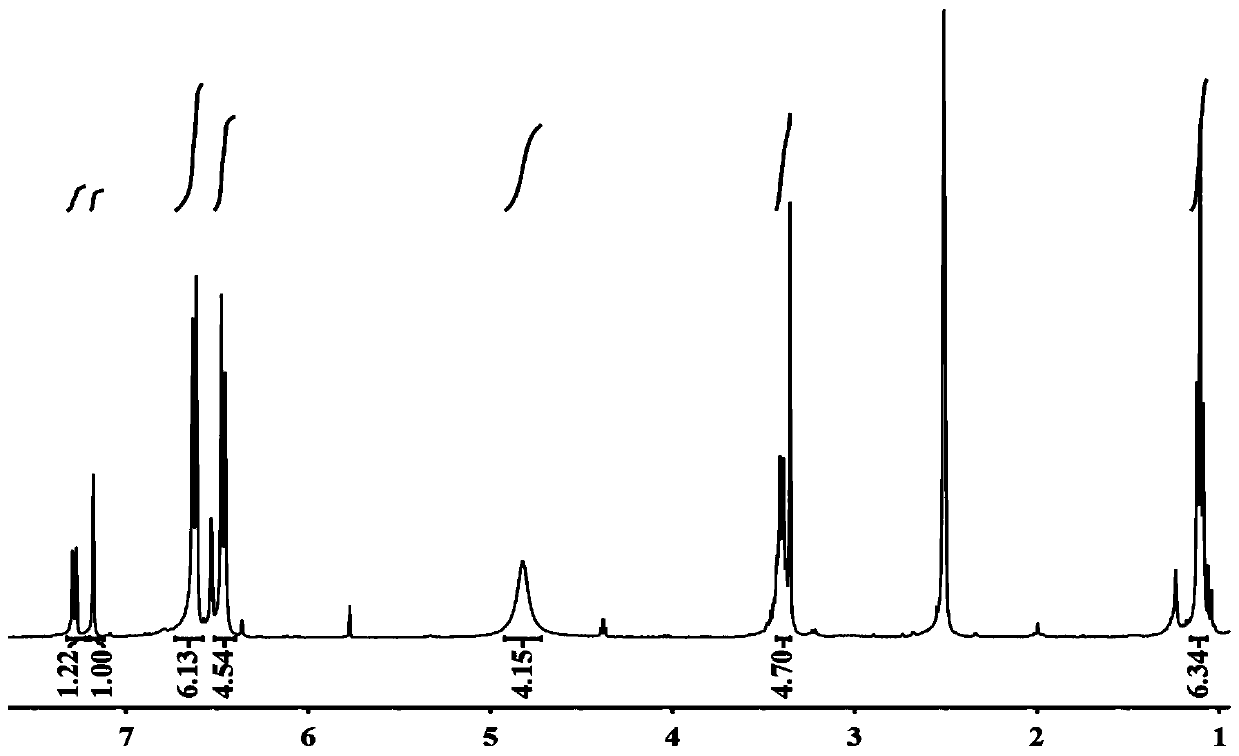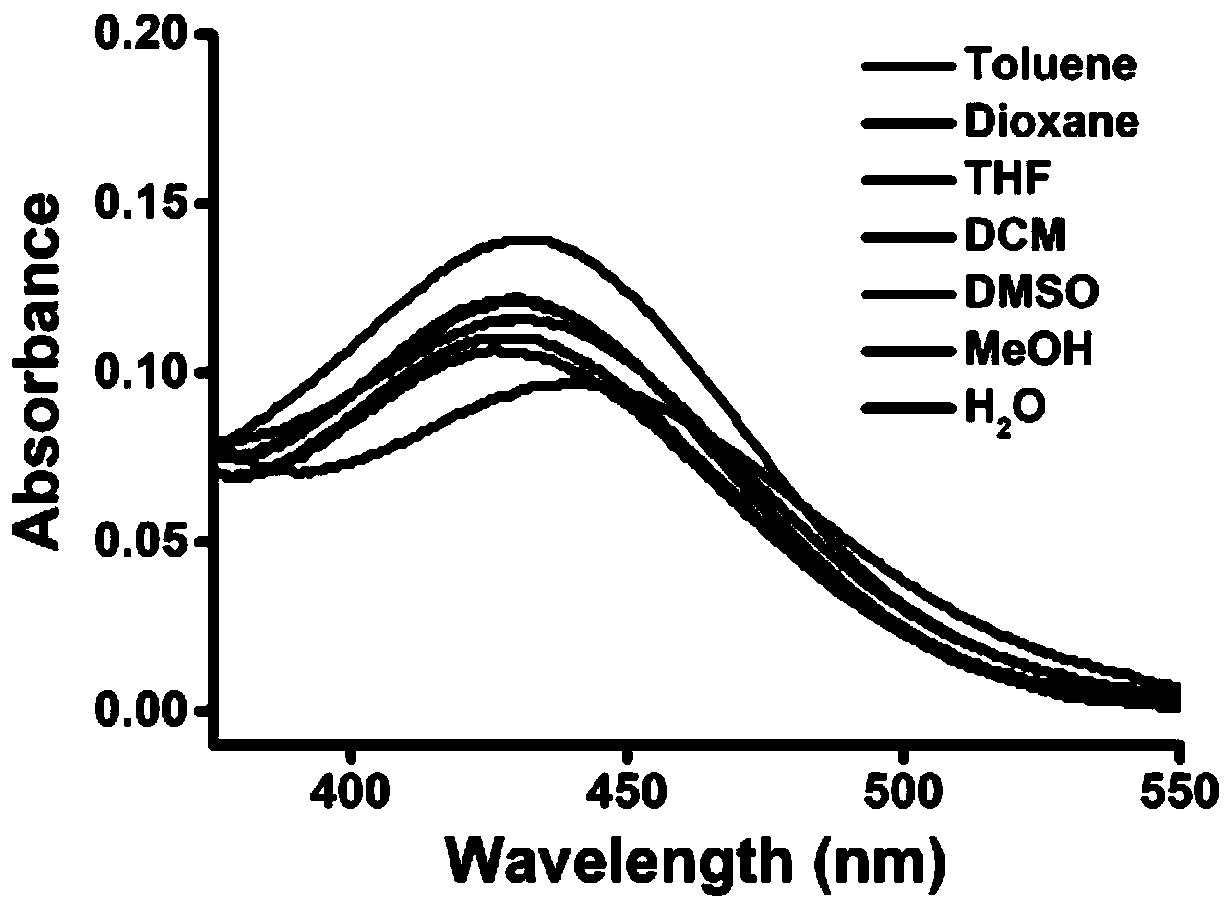Fluorescent probe for detecting polarity of lipid droplet and application thereof
A fluorescent probe and polarity technology, applied in the field of organic small molecule fluorescent probes, can solve the problems of inconvenient wide application, invasive operation, etc., and achieve good specific response to polarity, high yield, and simple synthesis steps. Effect
- Summary
- Abstract
- Description
- Claims
- Application Information
AI Technical Summary
Problems solved by technology
Method used
Image
Examples
Embodiment 1
[0035] Example 1 Synthesis of Fluorescent Probes
[0036] (1) Synthesis of compound 3-amino-7-diethylaminocoumarin: 3-nitro-7-diethylaminocoumarin (1) is stirred with tin chloride in concentrated hydrochloric acid (the molar ratio is 1:3), reacted for 6 hours, neutralized by adding sodium hydroxide solution until the solution was neutral, and a yellow precipitate was precipitated, filtered by suction, and purified to obtain the compound 3-amino-7-diethylaminocoumarin (2):
[0037] ;
[0038] (2) Synthesis of compound 3-(bis-4-nitrophenyl)amino-7-diethylaminocoumarin: 3-amino-7-diethylaminocoumarin (2) and p-fluoronitro Stir benzene in dimethyl sulfoxide (molar ratio is 1:2), react for 1 hour, add catalyst-cesium fluoride, react for 12 hours, precipitate yellow precipitate with deionized water, and purify by suction filtration to obtain compound 3-( Bis-4-nitrophenyl)amino-7-diethylaminocoumarin (3):
[0039] ;
[0040] (3) Synthesis of fluorescent probe: 3-(bis-4-nitro...
Embodiment 2
[0043] Example 2 UV spectra of fluorescent probes in different polar solvents
[0044] A fluorescent probe stock solution with a concentration of 1 mM was prepared as a spare, and dimethyl sulfoxide was used as a solvent. Add 10 μL of probe master solution to 2 mL of solvents of different polarities, and the final probe concentration is 5 μM. The solvents are listed in descending order of polarity: toluene, 1,4-dioxane, tetrahydrofuran, methylene chloride, dimethyl sulfoxide, methanol, and deionized water. Detect the ultraviolet absorption spectrum of each solvent, such as figure 2 Shown: The probe has different maximum absorption wavelengths in different polar solvents.
Embodiment 3
[0045] Example 3 Fluorescence spectra of fluorescent probes in solvents of different polarities
[0046] Prepare 10 mL of the fluorescent probe mother solution obtained in the example with a concentration of 1 mM as a spare, and use dimethyl sulfoxide as the solvent. Add 20 μL of the probe master solution to 2 mL of solvents of different polarities, and the final concentration of the probe is 10 μM. The solvents are listed in descending order of polarity: toluene, 1,4-dioxane, tetrahydrofuran, methylene chloride, dimethyl sulfoxide, methanol, and deionized water. The excitation wavelength is 415nm, and the fluorescence spectrum of the fluorescent probe in each solvent is detected, such as image 3 shown. Depend on image 3 It can be seen that with the increase of polarity, the maximum emission wavelength of the probe presents an obvious trend of red shift.
PUM
 Login to View More
Login to View More Abstract
Description
Claims
Application Information
 Login to View More
Login to View More - R&D
- Intellectual Property
- Life Sciences
- Materials
- Tech Scout
- Unparalleled Data Quality
- Higher Quality Content
- 60% Fewer Hallucinations
Browse by: Latest US Patents, China's latest patents, Technical Efficacy Thesaurus, Application Domain, Technology Topic, Popular Technical Reports.
© 2025 PatSnap. All rights reserved.Legal|Privacy policy|Modern Slavery Act Transparency Statement|Sitemap|About US| Contact US: help@patsnap.com



